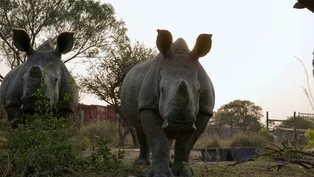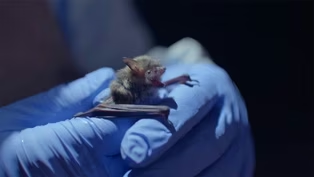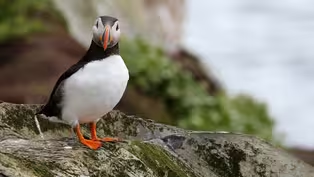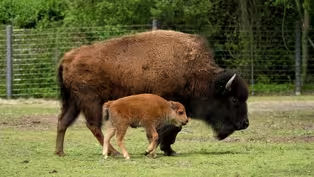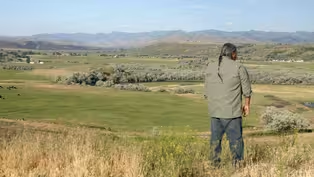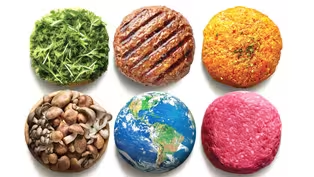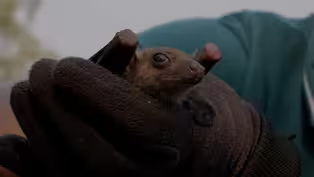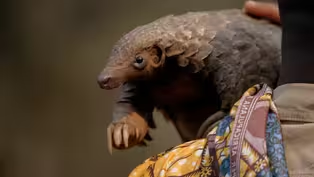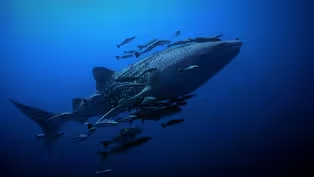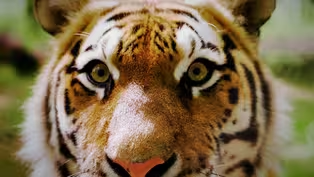
Building for Birds | WILD HOPE
Special | 16m 3sVideo has Closed Captions
Millions of migrating birds pass through our yards, but glass windows pose a deadly threat.
Millions of birds pass through our yards during their bi-annual migrations, but they face an invisible killer along the way: glass windows. In the US alone, an estimated one billion birds die each year when they collide with windows. Now, two organizations help pave the way to a bird-friendly future.
Problems playing video? | Closed Captioning Feedback
Problems playing video? | Closed Captioning Feedback
Major support for NATURE is provided by The Arnhold Family in memory of Henry and Clarisse Arnhold, Sue and Edgar Wachenheim III, The Fairweather Foundation, Charles Rosenblum, Kathy Chiao and...

Building for Birds | WILD HOPE
Special | 16m 3sVideo has Closed Captions
Millions of birds pass through our yards during their bi-annual migrations, but they face an invisible killer along the way: glass windows. In the US alone, an estimated one billion birds die each year when they collide with windows. Now, two organizations help pave the way to a bird-friendly future.
Problems playing video? | Closed Captioning Feedback
How to Watch Nature
Nature is available to stream on pbs.org and the free PBS App, available on iPhone, Apple TV, Android TV, Android smartphones, Amazon Fire TV, Amazon Fire Tablet, Roku, Samsung Smart TV, and Vizio.
Buy Now
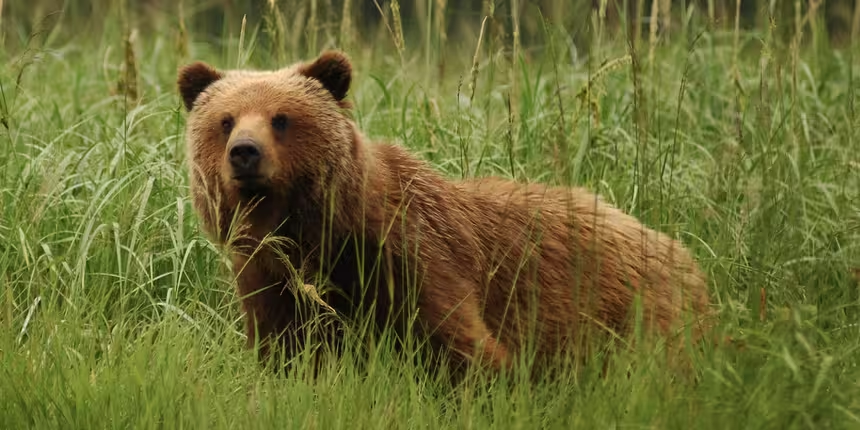
Explore More Ways to Watch
Bring the beauty and wonders of wildlife and natural history into your home with classic NATURE episodes.Providing Support for PBS.org
Learn Moreabout PBS online sponsorshipMore from This Collection
WILD HOPE is a new series of short films that highlights the intrepid changemakers who are restoring our wild places and sparking new hope for the future of our planet.
Video has Closed Captions
How does a densely populated nation like Singapore transform into a lush green oasis? (14m 51s)
Video has Closed Captions
For decades, rhinos have been the face of poaching. (16m 28s)
Video has Closed Captions
As a deadly fungus devastates North America’s bats, scientists are testing new ways to save them. (14m 47s)
Video has Closed Captions
In the Westman Islands, one community has banded together to save lost young puffins. (13m 15s)
Video has Closed Captions
Sixty million American bison once thundered across the prairies of North America. (18m 52s)
Reclaiming Bear River | WILD HOPE
Video has Closed Captions
The Bear River was once a lush area with wetlands, hot springs, and abundant wildlife. (17m 25s)
Mission Impossible | WILD HOPE
Video has Closed Captions
Meet the genius behind the plant-based Impossible Burger. (39m 41s)
Pangolin Protectors | WILD HOPE
Video has Closed Captions
Due to the demand for their scales, pangolins are the most trafficked animal in the world. (12m 24s)
Way of the Elephants | WILD HOPE
Video has Closed Captions
Elephant migration corridors in India are a necessary thoroughfare for one of the largest animals. (15m 11s)
Whale Shark Homecoming | WILD HOPE
Video has Closed Captions
A renowned spiritual leader is inspiring fishermen to become guardians of the world’s biggest fish. (16m 49s)
Video has Closed Captions
The artificial intelligence keeping tigers at bay. (14m 31s)
Providing Support for PBS.org
Learn Moreabout PBS online sponsorshipDUSTIN: We have to corral these chicks, catch them, and we're going to put little bracelets on them.
They think we're a predator, and they're going to scream, and they're gonna dive bomb you, like that.
Or expect to get pooped or vomited on.
Split up a little bit, this way!
(birds screaming) So let's move quick through here!
(birds screaming) Grab those ones.
Yeah, grab that one.
(birds screaming) (wings flapping) NARRATOR: These herring gull chicks hatched on a building that was once a notorious bird killer.
DUSTIN: Most people have heard that horrible sound of like a doonk, (thuds) of the bird hitting glass.
That is most often lethal.
And the Javits Center used to be one of the biggest bird killers in New York City.
NARRATOR: But the center has transformed.
This rooftop is now a safe haven amid the city's canyons of glass and steel.
It has joined a growing movement to make buildings across the country bird-friendly.
DUSTIN: Collisions happen everywhere.
We can change that.
(scraping) ♪ ♪ SARA: Hi!
Hi.
Who's hungry?
♪ Who's hungry?
♪ (bird chirping) Yeah... NARRATOR: Sara Hallager is the curator of birds at the National Zoo in Washington, D.C. ♪ (bird chirping) She oversees the care of nearly eighty species.
SARA: We save species here at the zoo, but that also includes the wild birds coming through during migration.
People think that they're just common backyard birds, but they're actually tropical birds that just happen to breed in our backyard.
For example, the Baltimore oriole.
In a couple months it's going to be in someone else's backyard in Nicaragua.
It's a bird that traverses the hemisphere.
♪ NARRATOR: Like New York City, Washington, D.C. sits in the middle of a major migration route, known as the Atlantic Flyway.
♪ It stretches from South America to the Arctic Circle.
Millions of birds across five hundred species follow this route.
♪ SARA: They migrate thousands of miles and they do this twice a year.
In the fall, you have a lot of baby birds leaving the nest, starting to head south.
And in the spring, the birds are returning in huge numbers.
NARRATOR: Along the way, these birds face a gauntlet of manmade threats.
They frequently fall victim to cats, ingest poisonous pesticides, or collide with glass.
(thuds) (leaves rustling) BRIAN: If you're a house sparrow that lives in the city, you probably know that that building is there.
It's those birds that are moving through this environment that are naive to these buildings.
(bird calling) NARRATOR: Brian Evans is a Smithsonian ecologist.
He's well aware of the risks migrating birds face.
BRIAN: Even the strongest and the smartest birds can collide with windows.
I myself have collided into many-a-sliding glass door.
(thuds) NARRATOR: Birds perceive windows as trees, sky, or simply space to fly through.
♪ Even the National Zoo, whose mission is to protect animals, has a bird problem: ten thousand square feet of glass that reflects prime bird habitat.
SARA: They have hollow bones.
They hit these glass panes at very high speeds, and it's usually fatal.
NARRATOR: Birds that survive a strike usually succumb to internal injuries later.
DUSTIN: Bird collisions often don't leave much evidence.
We find maybe three to 10% of the birds that actually hit glass.
What we do know is that in the U.S. alone, over a billion birds die each year because of these collisions.
NARRATOR: A billion birds, every single year.
♪ For Brian, it's more than just a number.
He and colleague Tara Snedgen get to know individual birds passing through D.C. BRIAN: We had this one ruby-throated hummingbird breeding here in D.C. Once every year it's going to leap across the Gulf of Mexico.
That is an incredibly energetically costly journey.
NARRATOR: The hummingbird crosses roughly five hundred miles of open ocean, from Florida to Mexico, in a single, twenty hour sprint.
BRIAN: That bird had made that journey at least twice, only to come back to Washington, D.C. and strike a window on M Street.
To think that this bird made this brave journey so many times to strike a window?
We can change that.
Alright!
NARRATOR: Brian, Sara, and Tara employ a simple, but effective solution at the zoo.
They make the windows visible to the birds.
♪ SARA: We are going around the zoo and putting up these dots on many different windows.
It's a bit of a tedious task, but we have perfected the technique.
NARRATOR: These decals go up en masse to make the glass look like a barrier.
BRIAN: When you cover a window with dots, you know that that's a window that's most likely not going to have a bird strike.
♪ NARRATOR: Today, the team is targeting the main window in the red wolf enclosure.
BRIAN: I'm ready for tape and level, we don't need the sharpie.
Just the dots, yeah.
Now, can somebody grab that scraper?
What makes these dots effective is their spacing more than anything else, which is every two inches.
Alright, in a second you're gonna press.
SARA: The science has shown us that two inches is the magic bullet.
Birds don't think they can fly through that space.
♪ NARRATOR: Individually placed decals, like bird of prey stickers, don't work.
It's the two inch spacing that makes a window stand out to birds.
SARA: These dots are absolutely effective.
When we finish a window, we literally say, we saved birds today.
It's a very good feeling.
We have many dots left to go, but we are getting there slowly but surely.
Watch that wolf come and lick them all off.
(Brian laughs) ♪ NARRATOR: The dots are effective, but they wear out and need to be replaced every ten to fifteen years.
They're not practical for the towering skyscrapers further north on the Atlantic Flyway.
♪ (water splashing) (birds calling) Most migrating birds travel at night when there's less wind and fewer predators.
But with cities like New York, we've changed the equation, disorienting these nocturnal navigators.
DUSTIN: We invented artificial light and it lit up the skies, and that's attractive to birds.
Birds will change routes and actually head into cities.
NARRATOR: The next morning, they find themselves in a maze of glass buildings, like the Jacob K. Javits Convention Center.
DUSTIN: That's one of the most dangerous areas for collisions in New York City.
It's because birds are staging in this area that is surrounded by water.
They're landing there after a long distance and they're trying to find fuel.
About 4500 birds a year were dying.
It's all that glass.
♪ NARRATOR: When it came time to renovate, the Javits Center set out to change the stats.
They partnered with the New York City Bird Alliance to make the complex bird-friendly.
Roughly six thousand panes of glass were retrofitted as part of a complete redesign.
♪ DUSTIN: All of that highly lethal glass was replaced with glass that is now visible to birds.
It's a visible pattern spaced out at least two inches by two inches.
That works.
♪ NARRATOR: The changes reduced bird strikes by ninety percent.
But the redesign didn't stop there.
♪ (leaves rustling) Javits is now a green oasis, habitat for migratory birds in a concrete city.
♪ (leaves rustling) ♪ (water sprinkling) ♪ (leaves rustling) DUSTIN: We have 65 species of bird that we've observed using this roof as stopover habitat, a place to fuel up and then rest before the next night's migration.
We also have about 160 nesting pairs of herring gulls on the roof.
Herring gulls, which are often thought of just like, they're just gulls.
They're going to steal my hot dog at the beach, but they're a species that are in steep decline since the 1970s.
We've lost a huge percentage of them.
(birds calling) NARRATOR: The Javits rooftop now gives these chicks a safe place to grow up, and scientists the opportunity to study them.
KYRIANA: They're covered in down, so they're just so warm.
CHRISTINE: I want to make sure it's as comfortable as possible!
♪ DUSTIN: These little bracelets let us know who that individual is and then we can track them over their lifespan.
The birds today, you might see them 25 years from now, coming back here to nest.
NARRATOR: Once mature, the Javits's chicks will fly as far away as Texas and Toronto.
DUSTIN: We can kind of put them down, make sure their feet are on the ground, and then you're gonna let them go.
And you'll see that some of them will stay there, some of them will turn around and yell at you.
Some of them will run, and some of them will just kind of fall over.
♪ (birds calling) ♪ NARRATOR: The Javits Center's transformation has become a symbol of how to make buildings bird-friendly.
DUSTIN: Javits really was the first in New York City.
We were able to point to what actually happens when you make change.
That's led to legislations.
New York now has local law 15.
That will make all glass bird-safe over time, that's a big deal.
NARRATOR: And it's not just New York that's making policy for the birds.
SARA: Law 24-337, all new construction in Washington, D.C. has to have bird-friendly glass.
NARRATOR: Seventeen cities and five states have now passed laws for bird-friendly construction.
♪ And in D.C., the National Zoo rebuilt the bird house to protect birds inside and out.
SARA: It was the first new building in Washington, D.C. built with bird-friendly glass.
(birds chirping) This was a complete redo of the bird house and very proud to say that since it was installed, we've had no bird strikes.
♪ (birds chirping and calling) NARRATOR: Javits and the National Zoo have made modifications on a grand scale, but smaller efforts can have a big impact too.
♪ Most collisions occur at eleven stories or below, where trees are reflected.
That means changes to our schools, businesses, and homes can save a lot of birds.
BRIAN: Alright, so we're going to put on this special tape, it's called Bird Tape.
And this is going to prevent window collisions.
♪ SARA: We want to tell people what they can do to help animals.
And making their windows bird-friendly is a terrific way to save birds.
It really does make a difference.
NARRATOR: As long as they go on the outside and follow the two inch rule, these dots make all the difference for the birds and don't obstruct our view.
SARA: They almost disappear.
When you're looking out your window, you really don't notice them.
NARRATOR: Other solutions include specially made Bird Tape, ♪ temporary paint.
♪ ROWAN: Wow, a rainbow!
♪ NARRATOR: And even window screens.
♪ BRIAN: It doesn't have to cost a lot of money.
One really inexpensive option is a bar of soap.
If you take a bar of soap, you can make lines in your window.
You'd apply it during migration, once in the spring and once during the fall.
NARRATOR: Methods that wash off are best applied during migration season, when more birds are at risk.
SARA: If all homeowners in the United States made their windows bird-friendly, we could save half a billion birds.
♪ As long as you keep that two inch spacing.
That's the key.
KELLY: That looks so good!
(wings flapping) ♪ BRIAN: These wild animals are on a tightrope walk.
If we change the balance just a little bit, we are going to save millions of lives of birds if we do this.
♪ (sticker peels) ♪ ♪ ♪ ♪ ♪

- Science and Nature

Explore scientific discoveries on television's most acclaimed science documentary series.

- Science and Nature

Learn how centuries of knowledge helped our ancestors understand the mysteries of space.












Support for PBS provided by:
Major support for NATURE is provided by The Arnhold Family in memory of Henry and Clarisse Arnhold, Sue and Edgar Wachenheim III, The Fairweather Foundation, Charles Rosenblum, Kathy Chiao and...

